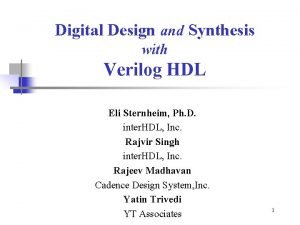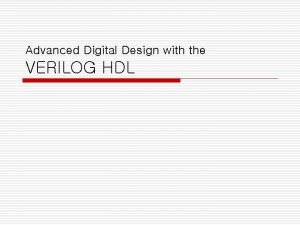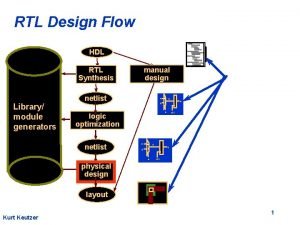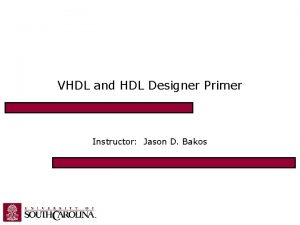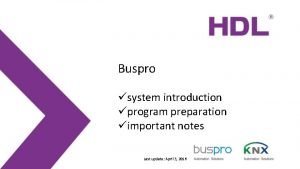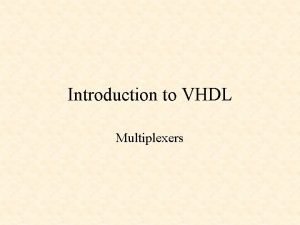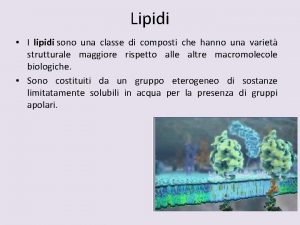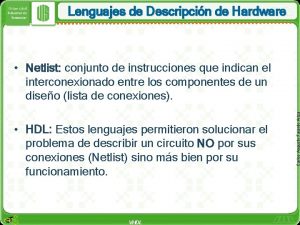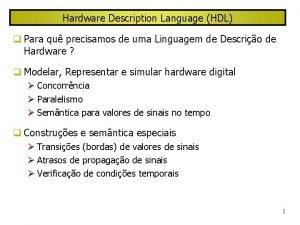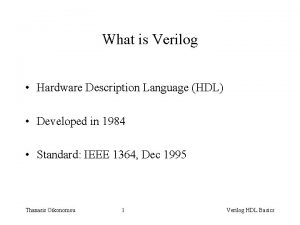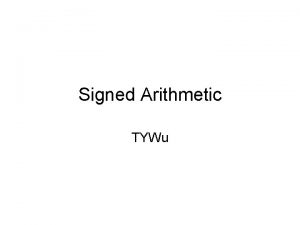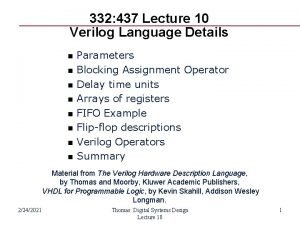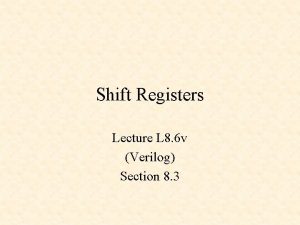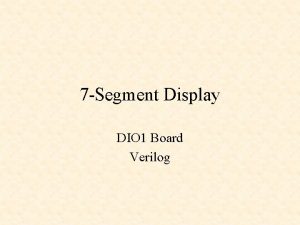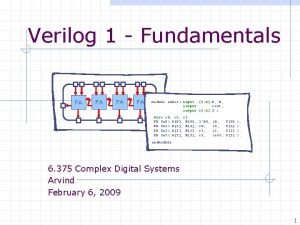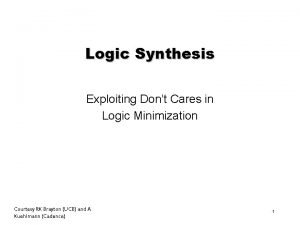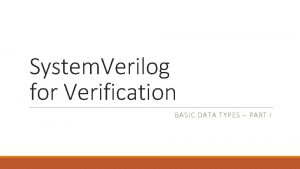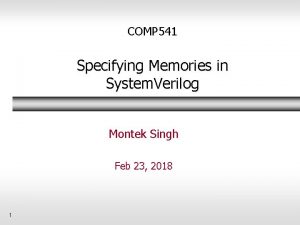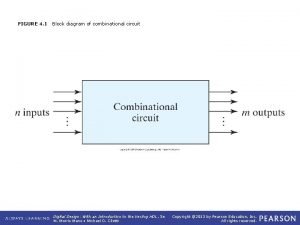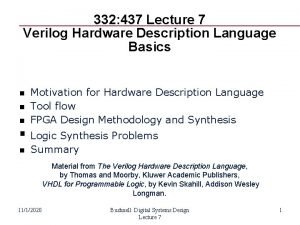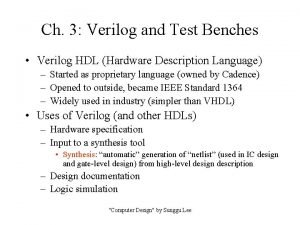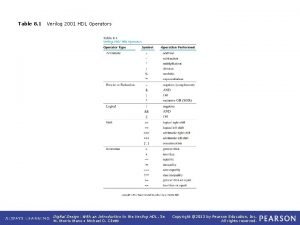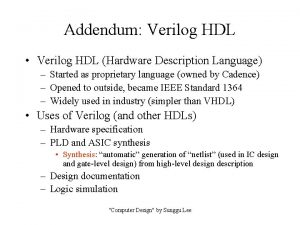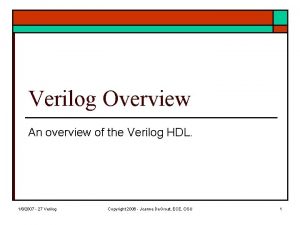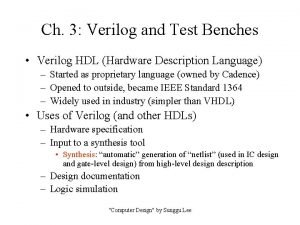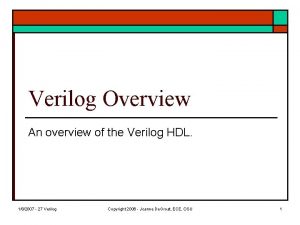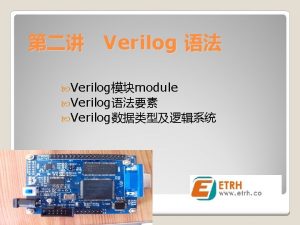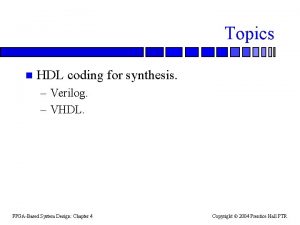Verilog HDL n 1 2 3 4 Verilog























![Verilog HDL 数字系统设计 reg[2: 0] Colt; . . . Colt = 2; force Colt Verilog HDL 数字系统设计 reg[2: 0] Colt; . . . Colt = 2; force Colt](https://slidetodoc.com/presentation_image_h2/892e3fa6c7438c569df3f9923592786e/image-24.jpg)


![Verilog HDL 数字系统设计 module Interacting (Serial_In, Clk, Parallel_Out); input Serial_In, Clk; output [0: 7] Verilog HDL 数字系统设计 module Interacting (Serial_In, Clk, Parallel_Out); input Serial_In, Clk; output [0: 7]](https://slidetodoc.com/presentation_image_h2/892e3fa6c7438c569df3f9923592786e/image-27.jpg)







![Verilog HDL 数字系统设计 端口说明 module Micro (PC, Instr, Next. Addr ); input [3: 1] Verilog HDL 数字系统设计 端口说明 module Micro (PC, Instr, Next. Addr ); input [3: 1]](https://slidetodoc.com/presentation_image_h2/892e3fa6c7438c569df3f9923592786e/image-35.jpg)







![Verilog HDL 数字系统设计 module Child(Pba, Ppy) ; input [5: 0] Pba; output [2: 0] Verilog HDL 数字系统设计 module Child(Pba, Ppy) ; input [5: 0] Pba; output [2: 0]](https://slidetodoc.com/presentation_image_h2/892e3fa6c7438c569df3f9923592786e/image-43.jpg)





![Verilog HDL 数字系统设计 外部端口 n 外部可见的模块端口 module Scram_A(Arb, Ctrl, Mem_Blk, Byte); input[0: 3] Arb; Verilog HDL 数字系统设计 外部端口 n 外部可见的模块端口 module Scram_A(Arb, Ctrl, Mem_Blk, Byte); input[0: 3] Arb;](https://slidetodoc.com/presentation_image_h2/892e3fa6c7438c569df3f9923592786e/image-49.jpg)






![Verilog HDL 数字系统设计 module Scram_C (Arb[0: 2] , Ctrl, {Mem_Blk[0] , Mem_Blk[1]} , Byte[3] Verilog HDL 数字系统设计 module Scram_C (Arb[0: 2] , Ctrl, {Mem_Blk[0] , Mem_Blk[1]} , Byte[3]](https://slidetodoc.com/presentation_image_h2/892e3fa6c7438c569df3f9923592786e/image-56.jpg)

![Verilog HDL 数字系统设计 module Scram_D (. Data(Arb[0: 2]), . Control(Ctrl), . Mem_Word({Mem_Blk[0], Mem_Blk[1]}), . Verilog HDL 数字系统设计 module Scram_D (. Data(Arb[0: 2]), . Control(Ctrl), . Mem_Word({Mem_Blk[0], Mem_Blk[1]}), .](https://slidetodoc.com/presentation_image_h2/892e3fa6c7438c569df3f9923592786e/image-58.jpg)



![Verilog HDL 数字系统设计 结构模型描述十进制计数器 module Decade_Ctr (Clock, Z) ; input Clock; output [0: 3] Verilog HDL 数字系统设计 结构模型描述十进制计数器 module Decade_Ctr (Clock, Z) ; input Clock; output [0: 3]](https://slidetodoc.com/presentation_image_h2/892e3fa6c7438c569df3f9923592786e/image-62.jpg)

- Slides: 63

Verilog HDL 数字系统设计 循环语句 n 1. 2. 3. 4. Verilog HDL中有四类循环语句: forever循环 repeat循环 while循环 for 循环


Verilog HDL 数字系统设计 reg clk; initial begin clk = 0; forever begin #10 clk = 1; #20 clk = 0; end


Verilog HDL 数字系统设计 参数化移位乘法器 module multiplier(result, op_a, op_b); parameter size = 8; input [size: 1] op_a, op_b; output [2*size: 1] result; reg [2*size: 1] shift_opa, result; reg [size: 1] shift_opb; always @(op_a or op_b) begin result = 0; shift_opa = op_a; // Zero extend left shift_opb = op_b; repeat (size) begin #10 if (shift_opb[1]) result = result + shift_opa; shift_opa = shift_opa << 1; // Shift left shift_opb = shift_opb >> 1; // Shift right end endmodule




Verilog HDL 数字系统设计 initial begin count = 0; while (count < 101) begin $display (“Count = %d”, count); count = count + 1; end reg [15: 0] Word; while (Word) begin if (Word[0]) Count. Ones = Count. Ones + 1; Word = Word >> 1; end


Verilog HDL 数字系统设计 // 寻找x for (index = 0; index < size; index = index + 1) if (val[index] === 1'bx) $display ("found an X"); // 存储器赋值 for (i = size; i != 0; i = i - 1) memory[i-1] = 0; // 阶乘 factorial = 1; for (j = num; j != 0; j = j - 1) factorial = factorial * j;

Verilog HDL 数字系统设计 integer i; // declare the index for the FOR LOOP always @(inp or cnt) begin result[7: 4] = 0; result[3: 0] = inp; if (cnt == 1) begin for (i = 4; i <= 7; i = i + 1) begin result[i] = result[i-4]; end result[3: 0] = 0; end


Verilog HDL 数字系统设计 begin: break for (I = 0; I < n; I = I + 1) begin: continue if (a == 0) disable continue; … if (a == b) disable break end




Verilog HDL 数字系统设计 module latch_quasi (q, en, d); input en, d; output q; reg q; always @(en) if (en) assign q = d; else deassign q; endmodule



Verilog HDL 数字系统设计 assign 和 deassign 覆盖寄存器上的当前值。 reg state_reg ; initial begin #10 assign state_reg = 2 ; #20 deassign state_reg ; end n


Verilog HDL 数字系统设计 reg(wire) scan_reg. q ; initial begin #10 force scan_reg. q = 0 ; #20 release scan_reg. q ; end
![Verilog HDL 数字系统设计 reg2 0 Colt Colt 2 force Colt Verilog HDL 数字系统设计 reg[2: 0] Colt; . . . Colt = 2; force Colt](https://slidetodoc.com/presentation_image_h2/892e3fa6c7438c569df3f9923592786e/image-24.jpg)
Verilog HDL 数字系统设计 reg[2: 0] Colt; . . . Colt = 2; force Colt = 1; . . . release Colt; // Colt 保持值为 1。. . . assign Colt = 5; . . . force Colt = 3; . . . release Colt; // Colt值变为 5。. . .


![Verilog HDL 数字系统设计 module Interacting SerialIn Clk ParallelOut input SerialIn Clk output 0 7 Verilog HDL 数字系统设计 module Interacting (Serial_In, Clk, Parallel_Out); input Serial_In, Clk; output [0: 7]](https://slidetodoc.com/presentation_image_h2/892e3fa6c7438c569df3f9923592786e/image-27.jpg)
Verilog HDL 数字系统设计 module Interacting (Serial_In, Clk, Parallel_Out); input Serial_In, Clk; output [0: 7] Parallel_Out; reg Ready, Ack; wire [0: 7] data; `include "Read_Word. v" // Read_Word任务在此文件中定义。

Verilog HDL 数字系统设计 always begin: RX Read_Word(Serial_In, Clk, Data) ; / *任务Read_Word在每个时钟周期 读取串行数据,将其转换为并行 数据并存于Data中。*/ Ready = 1; wait(Ack) ; Ready = 0; # 40 ; end always begin: MP # 25 ; Parallel_Out = Data; Ack = 1; #25 Ack = 0; wait (ready) ; endmodule

Verilog HDL 数字系统设计 同步vs. 异步 module sync (d, clk, clr, pre, q); input d, clk, clr, pre ; output q ; reg q ; always @(posedge clk) begin if (clr) q <= 1’b 0 ; else if (pre) q <= 1’b 1 ; else q <= d ; endmodule async (d, clk, clr, q); input d, clk, clr ; output q ; reg q ; always @(posedge clk or posedge clr) begin if (clr) q <= 1’b 0 ; else q <= d ; endmodule



Verilog HDL 数字系统设计 模块 Verilog HDL中,基本单元定义成模块形式,如下所示: module Module_name (Port_list) Port declarations (if ports are present) //端口队列port_list列出了该模块通过哪些端口与外部模块通信。 Parameters (optional) Data type declarations Continuous Assignments (assign) Procedural Blocks (initial and always) behavioral statements Instantiation of lower-level modules Tasks and Functions Timing Specifications endmodule n


![Verilog HDL 数字系统设计 端口说明 module Micro PC Instr Next Addr input 3 1 Verilog HDL 数字系统设计 端口说明 module Micro (PC, Instr, Next. Addr ); input [3: 1]](https://slidetodoc.com/presentation_image_h2/892e3fa6c7438c569df3f9923592786e/image-35.jpg)
Verilog HDL 数字系统设计 端口说明 module Micro (PC, Instr, Next. Addr ); input [3: 1] PC; output [1: 8] Instr; inout [16: 1] Next. Addr; wire [16: 1] Next. Addr; //该说明是可选的,但如果指定了,就必须与 它的端口说明保持相同长度。显示说明。 reg [1: 8] Instr; / /Instr被说明为reg类型,因此它能在always 语句或在initial语句中赋值。. . . endmodule





Verilog HDL 数字系统设计 两个半加器模块构造全加器 module HA(A , B , S , C); input A , B; output S, C; assign #2 S= A ^ B; assign #1 C= A & B; endmodule FA(P, Q, Cin, Sum, Cout ) ; input P, Q, Cin; output Sum, Cout; parameter OR_DELAY = 1; wire S 1, C 2; HA h 1 (P, Q, S 1, C 1); //通过位置关联。 HA h 2 (. A(C i n), . S(S u m), . B(S 1), . C(C 2)); //通过端口与信号的名字关联。 or #2 O 1 (Cout, C 1, C 2) ; endmodule


![Verilog HDL 数字系统设计 module ChildPba Ppy input 5 0 Pba output 2 0 Verilog HDL 数字系统设计 module Child(Pba, Ppy) ; input [5: 0] Pba; output [2: 0]](https://slidetodoc.com/presentation_image_h2/892e3fa6c7438c569df3f9923592786e/image-43.jpg)
Verilog HDL 数字系统设计 module Child(Pba, Ppy) ; input [5: 0] Pba; output [2: 0] Ppy; . . . endmodule Top; wire [1: 2] Bdl; wire [2: 6] Mpr; Child C 1 (Bdl, Mpr) ; endmodule



Verilog HDL 数字系统设计 改变较低层次模块的参数 module full_adder(fco, fsum, cin, a, b); output fco, fsum; input cin, a, b; wire c 1, s 1, c 2; defparam u 1. and_delay = 4, u 1. xor_delay = 6; defparam u 2. and_delay = 3, u 2. xor_delay = 5; half_adder u 1(c 1, s 1, a, b); half_adder u 2(. a(s 1), . b(cin), . sum(fsum), . co(fco)); or u 3(fco, c 1, c 2); endmodule half_adder (a, b, sum, co); parameter and_delay = 8, xor_delay = 8; …. endmodule

Verilog HDL 数字系统设计 带参数值的模块引用 module full_adder(fco, fsum, cin, a, b); output fco, fsum; input cin, a, b; wire c 1, s 1, c 2; half_adder #(4, 6) u 1(c 1, s 1, a, b); half_adder #(3, 5) u 2(. a(s 1), . b(cin), . sum(fsum), . co(fco)); or u 3(fco, c 1, c 2); endmodule half_adder (a, b, sum, co); parameter and_delay = 8, xor_delay = 8; …. endmodule

![Verilog HDL 数字系统设计 外部端口 n 外部可见的模块端口 module ScramAArb Ctrl MemBlk Byte input0 3 Arb Verilog HDL 数字系统设计 外部端口 n 外部可见的模块端口 module Scram_A(Arb, Ctrl, Mem_Blk, Byte); input[0: 3] Arb;](https://slidetodoc.com/presentation_image_h2/892e3fa6c7438c569df3f9923592786e/image-49.jpg)
Verilog HDL 数字系统设计 外部端口 n 外部可见的模块端口 module Scram_A(Arb, Ctrl, Mem_Blk, Byte); input[0: 3] Arb; input Ctrl; input [8: 0] Mem_Blk; output [0: 3] Byte; . . . endmodule n Arb, Ctrl, Mem_Blk, Byte为模块端口。这些端口同时也是外部端口。 n 在模块Scram_A中,外部端口名称隐式地指定。


Verilog HDL 数字系统设计 n n HDL中提供显式方式指定外部端口名称。 语法形式:. external_port_name(internal_port_name)

Verilog HDL 数字系统设计 module Scram_B (. Data(Arb) , . Control(Ctrl) , . Mem_Word(Mem_Blk) , . Addr(Byte)) ; input[0: 3] Arb; input Ctrl; input [8: 0] Mem_Blk; output [0: 3] Byte; . . . endmodule n n 外部端口是Data、Control、Mem_Word和Addr。 内部端口是Arb, Ctrl, Mem_Blk, Byte



![Verilog HDL 数字系统设计 module ScramC Arb0 2 Ctrl MemBlk0 MemBlk1 Byte3 Verilog HDL 数字系统设计 module Scram_C (Arb[0: 2] , Ctrl, {Mem_Blk[0] , Mem_Blk[1]} , Byte[3]](https://slidetodoc.com/presentation_image_h2/892e3fa6c7438c569df3f9923592786e/image-56.jpg)
Verilog HDL 数字系统设计 module Scram_C (Arb[0: 2] , Ctrl, {Mem_Blk[0] , Mem_Blk[1]} , Byte[3] ) ; input [0: 3] Arb; input Ctrl; input [8: 0] Mem_Blk; output [0: 3] Byte; . . . endmodule

![Verilog HDL 数字系统设计 module ScramD DataArb0 2 ControlCtrl MemWordMemBlk0 MemBlk1 Verilog HDL 数字系统设计 module Scram_D (. Data(Arb[0: 2]), . Control(Ctrl), . Mem_Word({Mem_Blk[0], Mem_Blk[1]}), .](https://slidetodoc.com/presentation_image_h2/892e3fa6c7438c569df3f9923592786e/image-58.jpg)
Verilog HDL 数字系统设计 module Scram_D (. Data(Arb[0: 2]), . Control(Ctrl), . Mem_Word({Mem_Blk[0], Mem_Blk[1]}), . Addr(Byte[3])); input [0: 3] Arb; input Ctrl; input [8: 0] Mem_Blk; output [0: 3] Byte; . . . endmodule



Verilog HDL 数字系统设计 Verilog HDL允许一个内部端口能与多个 外部端口连接。 module Fan. Out (. A(Ctrl. In) , . B(Cond. Out), . C(Cond. Out)) ; input. Ctrl. In; output Cond. Out; assign Cond. Out = Ctrl. In; endmodule n
![Verilog HDL 数字系统设计 结构模型描述十进制计数器 module DecadeCtr Clock Z input Clock output 0 3 Verilog HDL 数字系统设计 结构模型描述十进制计数器 module Decade_Ctr (Clock, Z) ; input Clock; output [0: 3]](https://slidetodoc.com/presentation_image_h2/892e3fa6c7438c569df3f9923592786e/image-62.jpg)
Verilog HDL 数字系统设计 结构模型描述十进制计数器 module Decade_Ctr (Clock, Z) ; input Clock; output [0: 3] Z; and A 1 (S 1, Z[2], Z[1]); // 4个模块实例语句: JK_FF JK 1(. J(1'b 1), . K(1'b 1), . CK(Clock), . Q(Z[0]) , . NQ( )), JK 2(. J(S 2), . K(1'b 1), . CK(Z[0]), . Q(Z[1]) , . NQ()), JK 3(. J(1'b 1), . K(1'b 1), . CK(Z[1]), . Q(Z[2]), . NQ()), JK 4(. J(S 1), . K(1'b 1), . CK(Z[0]), . Q(Z[3]), . NQ(S 2)); endmodule

Verilog HDL 数字系统设计 3位可逆计数器的逻辑 module Up_Down(Clk, Cnt_Up, Cnt_Down, Q) ; input Clk, Cnt_Up, Cnt_Down; output [0: 2] Q; wire S 1, S 2, S 3, S 4, S 5, S 6, S 7, S 8; JK_FF JK 1(1'b 1, Clk, Q[0], S 1), JK 2(1'b 1, S 4, Q[1] , S 5), JK 3(1'b 1, S 8, Q[2], ); and A 1(S 2, Cnt_Up, Q[0]), A 2(S 3, S 1, Cnt_Down), A 3(S 7, Q[1], Cnt_Up), A 4(S 6, S 5, Cnt_Down); or O 1(S 4, S 2, S 3) , O 2(S 8, S 7, S 6); endmodule
 Structural vs dataflow verilog
Structural vs dataflow verilog Verilog
Verilog Verilog hdl
Verilog hdl Verilog hdl
Verilog hdl Verilog vs vhdl
Verilog vs vhdl Verilog hdl a guide to digital design and synthesis
Verilog hdl a guide to digital design and synthesis Hdl rtl
Hdl rtl Advanced digital design with the verilog hdl
Advanced digital design with the verilog hdl Rtl design flow
Rtl design flow Triglicerido
Triglicerido Hdl-mbus01ip.431
Hdl-mbus01ip.431 Hdl knx
Hdl knx Hdl formation
Hdl formation Hdl level
Hdl level Hdl ldl
Hdl ldl Hdl tomato soup
Hdl tomato soup Hdl designer tutorial
Hdl designer tutorial Fungsi hdl
Fungsi hdl Hdl genesys
Hdl genesys Nand 2 tetris
Nand 2 tetris Hdl buspro setup tool 2 download
Hdl buspro setup tool 2 download Verilog code
Verilog code A stepper motor hdl application must include
A stepper motor hdl application must include Multiplexer vhdl
Multiplexer vhdl Chisel hdl
Chisel hdl Circolo enteroepatico farmaci
Circolo enteroepatico farmaci Lenguajes de descripción de hardware (hdl)
Lenguajes de descripción de hardware (hdl) Vhdl hardware description language
Vhdl hardware description language Abel hdl
Abel hdl Pediatra balestra seriate
Pediatra balestra seriate Hdl normal range
Hdl normal range Low hdl
Low hdl Hdl-mcip-rf02.10
Hdl-mcip-rf02.10 Hdl is
Hdl is Hdl-mhrcu.433
Hdl-mhrcu.433 Language
Language Hdl level
Hdl level Is cholesterol a lipid
Is cholesterol a lipid Tetrisorg
Tetrisorg Hdl vhdl
Hdl vhdl Verilog
Verilog Scantch
Scantch Signed addition verilog
Signed addition verilog Hierarchical design in verilog
Hierarchical design in verilog Greg edmiston
Greg edmiston Verilog
Verilog Verilog shift register
Verilog shift register Lock logic
Lock logic Verilog 7 segment display
Verilog 7 segment display Subtractor verilog
Subtractor verilog Force release verilog
Force release verilog Traffic light controller verilog code and testbench
Traffic light controller verilog code and testbench Jdoodle verilog
Jdoodle verilog Verilog
Verilog Verilog dont care
Verilog dont care Verilog data type
Verilog data type Structural verilog
Structural verilog Verilog
Verilog Verilog
Verilog System verilog union
System verilog union Block diagram of combinational circuit
Block diagram of combinational circuit Verilog
Verilog Test bench in verilog
Test bench in verilog Verilog operators table
Verilog operators table





